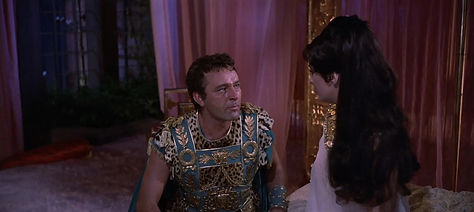
Scene Tone
An often subtle, but incredibly effective way in which color can help convey overarching themes throughout these films is in individual scenes themselves. Color can set distinct moods, convey specific emotions and messages, represent inner character conflicts, and general thematic elements through its role in particular shots and events throughout the story.
In the case of movie scenes, color often works in tandem with cinematography to communicate these certain messages, such as in the use of shadow.
Another place we can see this use of physical darkness and shadow to represent internal conflict or negativity is in the movie 300. In the scene between Leonidas and Queen Gorgo, where they speak to each other in bed, Leonidas is conflicted on if he should betray the Ephors and declare war, or uphold tradition. He speaks to his wife about this, seeking clarity, and the scene reflects his internal conflict with the decision, and his wife’s guiding position. She is in direct light, being bathed in white, while he remains primarily cast in shadow, only lit by the indirect light coming from her. Both of these examples show how scenes can be shaped and guided by the use of light and dark tones, visually communicating deeper messages to the audience than are able to be spoken verbally.
A striking example of this is in Gladiator (2000), in the scene where Maximus finally comes home only to find his land destroyed and family murdered. The hanging feet of his wife and son are black, with either shadow or char, and the only other place we see this stark black reflected in the scene is in Maximus’ crumbled form beneath them. His entire body is cast in complete shadow, a silhouette of black, representing this incredibly horrific moment for him. The connection between his internal darkness and the cause being the death of his family is reflected in this color parallel between the two, as well as outwardly portraying his inner torment.

Figure 1: Maximus Finding his Family, Gladiator (2000)

Figure 2: Leonidas in Bed Scene, 300 (2007)

Figure 3: Queen Gorgo in Bed Scene, 300 (2007)
Though it is not only negativity and conflict conveyed with light and color. As seen in Hercules, the grand celebratory ending is cemented visually through the mixing of an incredibly saturated variety of colors. The sky darkens as the sun sets on the end of this story, though the characters remain bright. Though the celebration is clear to the viewer, the choices in saturation and palette drive home the truly euphoric quality of the scene as the gods (and mortals) rejoice in their happily-ever-after.

Figure 4: Olympus, Hercules (1997)

Figure 5: Hercules and Gods, Hercules (1997)
While the use of lights and shadow, and the colors of them, do play into the general tone of a scene, some scenes have a single tone to characterize them. For example, pink is commonly used to portray romance and intimacy. This is shown in Quo Vadis, when Poppée is attempting to seduce Marcus Vinicius they are surrounded by fuchsia curtains.
Blue is one of the most common scene tones of all in toga movies. This is likely due to its perfect use in action scenes, as a cold blue represents danger and suspense. Desaturated blue is used in Gladiator as Maximus is attempting to escape, building the suspense and uneasiness before his eventual capture. It can also be used to show a cold relationship between characters, as is done between Lucilla and Maximus at the start of the film.
Much more commonly used, pure yellow (more specifically yellow ochre), is often seen in personal moments. Such as in 300, yellow is used when Leonidas is imagining his wife in a personal moment before his death. And contrasting with the cold blue scene of their relationship in the beginning of the film, Maximus and Lucilla’s relationship grows significantly closer, which is visually shown in the use of warm yellow nearer to the film’s end.
Though it isn’t only singular tones that can add specific qualities to scenes, but pairs as well. Complementary pairs are very commonly used because of their visually pleasing nature, such as blue and orange. This pair in particular often characterizes action scenes, as the previously discussed suspenseful and unsettling nature of blue pairs very well with the orange point of action, such as fire, to grab the audience’s attention. The second most commonly used complementary pair is that of purple and yellow. Again, the warm and personal nature of yellow continues to be utilized, while purple is mainly used for contrast in such moments.

Figure 6: Gladiator (2000)

Figure 7: Poppée and Marcus, Quo Vadis (1951)

Figure 8: Cleopatra and Mark Anthony, Cleopatra (1963)

Figure 9: Gladiator (2000)

Figure 10: Lucilla and Maximus, Gladiator (2000)

Figure 11: Queen Gorgo, 300 (2007)

Figure 12: Lucilla, Gladiator (2000)

Figure 13: Gladiator (2000)

Figure 14: Gladiator (2000)

Figure 15: Gladiator (2000)

Figure 16: Gladiator (2000)
Overall, the use of color in scenes is incredibly versatile and effective. It is used to convey specific messages, the internal emotional states of characters, as well as more general atmospheres. Color plays a crucial role in the conveying of emotion in particular moments of the story, adding to the larger picture and themes these movies are trying to tell.